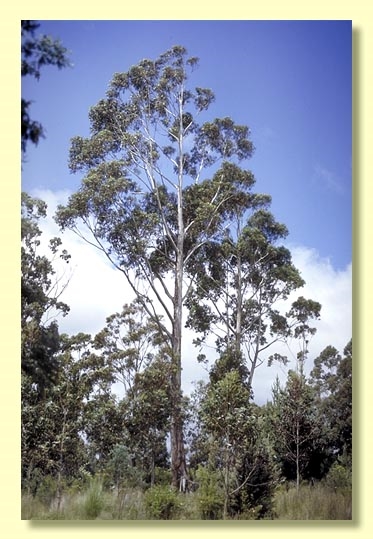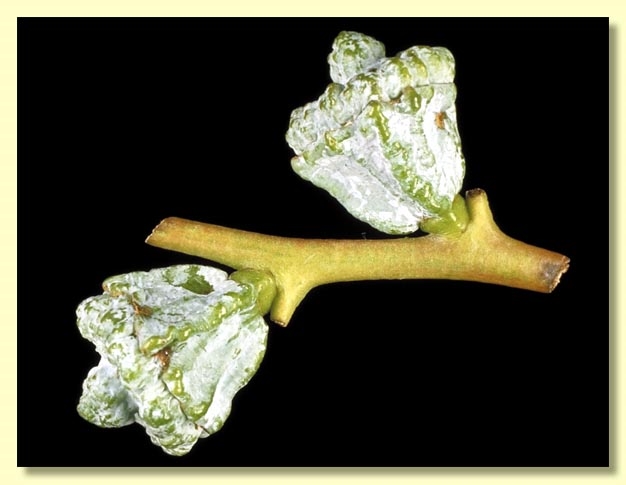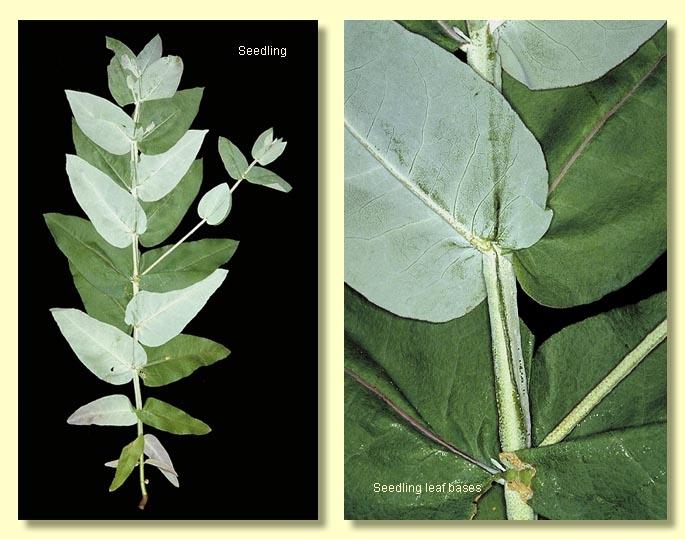Euclid - Online edition
Eucalyptus globulus subsp. globulus
Classification
Eucalyptus | Symphyomyrtus | Maidenaria | Euryotae | Globulares | Euglobulares
Nomenclature
Eucalyptus globulus Labill., Voy. Rech. Pérouse 1: 153, t. 13 (1800) subsp. globulus.
T: probably Recherche Bay, [Tasmania.], Dec. 1792, J.J.H. de Labillardière s.n. ; holo: FI; iso: BM, G, K, L, W.
Eucalyptus gigantea Dehnh., Catalogus Plantarum Horti Camaldulensis. 2nd edn, 6, 20 (1832). T: cultivated in Paris, France.
T: probably Recherche Bay, [Tasmania.], Dec. 1792, J.J.H. de Labillardière s.n. ; holo: FI; iso: BM, G, K, L, W.
Eucalyptus gigantea Dehnh., Catalogus Plantarum Horti Camaldulensis. 2nd edn, 6, 20 (1832). T: cultivated in Paris, France.
Description
Tree to 70 m tall. Forming a lignotuber.
Bark smooth apart from base which has persistent slabs, shedding in large strips and slabs; smooth bark white, cream, grey, yellowish or pale creamy orange, often with ribbons of decorticated bark in the upper branches.
Juvenile growth (coppice or field seedlings to 50 cm): stem square in cross-section and prominently winged, glaucous; juvenile leaves opposite and sessile for many pairs, oblong to elliptical then ovate to lanceolate, 4–10.5 cm long, 2.2–5 cm wide, base amplexicaul, margin sometimes crenulate, usually discolorous with upper surface green or slightly glaucous and the lower surface copiously white-waxy.
Adult leaves alternate, petiole 2–3.5 cm long; blade lanceolate to falcate, 12–30 cm long, 1.7–3 cm wide, glossy, green, side-veins greater than 45° to midrib, densely reticulate, intramarginal vein parallel to and well removed from margin, oil glands island and intersectional.
Inflorescence axillary unbranched, peduncle absent or short and stout, 0–0.5 cm long, bud solitary, sessile. Mature buds hypanthium obconical, glaucous, warty, with about 4 longitudinal ribs, 1.4–2.5 cm long, 1.4–2 cm wide, scar present, operculum flattened and umbonate, stamens inflexed, anthers cuboid to oblong, versatile, dorsifixed, dehiscing by longitudinal slits (non-confluent), style long, locules 4 or 5, the placentae each with 6(8) vertical ovule rows. Flowers white.
Fruit sessile, hemispherical or obconical, or square in cross section, 1–1.5 cm long, 1.4–2.7 cm wide, 4-ribbed longitudinally, glaucous, disc raised-convex and lobed over the 4 or 5 valves which are usually near rim level.
Seeds black, brown or grey, 2–4 mm long, ovoid to flattened-ovoid or slightly cuboid, often lacunose, dorsal surface shallowly pitted, hilum ventral.
Cultivated seedlings (measured at ca node 10): cotyledons bilobed; stems square in cross-section and prominently winged also, glaucous; leaves sessile, opposite for many nodes, oblong to ovate or elliptical, 6–12 cm long, 2.5–7 cm wide, amplexicaul, margin entire or subcrenulate, apex pointed, glaucous to blue.
Bark smooth apart from base which has persistent slabs, shedding in large strips and slabs; smooth bark white, cream, grey, yellowish or pale creamy orange, often with ribbons of decorticated bark in the upper branches.
Juvenile growth (coppice or field seedlings to 50 cm): stem square in cross-section and prominently winged, glaucous; juvenile leaves opposite and sessile for many pairs, oblong to elliptical then ovate to lanceolate, 4–10.5 cm long, 2.2–5 cm wide, base amplexicaul, margin sometimes crenulate, usually discolorous with upper surface green or slightly glaucous and the lower surface copiously white-waxy.
Adult leaves alternate, petiole 2–3.5 cm long; blade lanceolate to falcate, 12–30 cm long, 1.7–3 cm wide, glossy, green, side-veins greater than 45° to midrib, densely reticulate, intramarginal vein parallel to and well removed from margin, oil glands island and intersectional.
Inflorescence axillary unbranched, peduncle absent or short and stout, 0–0.5 cm long, bud solitary, sessile. Mature buds hypanthium obconical, glaucous, warty, with about 4 longitudinal ribs, 1.4–2.5 cm long, 1.4–2 cm wide, scar present, operculum flattened and umbonate, stamens inflexed, anthers cuboid to oblong, versatile, dorsifixed, dehiscing by longitudinal slits (non-confluent), style long, locules 4 or 5, the placentae each with 6(8) vertical ovule rows. Flowers white.
Fruit sessile, hemispherical or obconical, or square in cross section, 1–1.5 cm long, 1.4–2.7 cm wide, 4-ribbed longitudinally, glaucous, disc raised-convex and lobed over the 4 or 5 valves which are usually near rim level.
Seeds black, brown or grey, 2–4 mm long, ovoid to flattened-ovoid or slightly cuboid, often lacunose, dorsal surface shallowly pitted, hilum ventral.
Cultivated seedlings (measured at ca node 10): cotyledons bilobed; stems square in cross-section and prominently winged also, glaucous; leaves sessile, opposite for many nodes, oblong to ovate or elliptical, 6–12 cm long, 2.5–7 cm wide, amplexicaul, margin entire or subcrenulate, apex pointed, glaucous to blue.
Flowering Time
Flowering has been recorded from May through to January with peak flowering in September to November (see Williams & Potts, 1996, p. 70).
Forms of Eucalyptus globulus have commonly become naturalised in areas away from the species natural distribution in many places in southern Australia.
Notes
Eucalyptus globulus is a forest tree species that is widespread in the ranges and subcoastal forests of eastern New South Wales as far north as the Carrai Plateau, eastern, southern and central Victoria, and Tasmania. It is notable for the very conspicuous seedlings, coppice and young saplings with square stems and large, glaucous, oblong to ovate sessile juvenile leaves. The trunks are mostly smooth and the adult leaves are large, bright glossy green and usually falcate.
There are four subspecies:
E. globulus subsp. globulus
Of largely lowland distribution in Tasmania, including King Island and islands of the Furneaux group and Rodondo Island, and coastal and subcoastal distribution on the southernmost extremities in Victoria. It has a single, large, sessile, glaucous, warty bud per axil (rarely in threes) and the solitary fruit 1.4–2.7 cm wide.
E. globulus subsp. bicostata
A montane and tableland subspecies in eastern New South Wales occurring as far north as the Carrai Plateau, and in Victoria mostly on the slopes of the Great Dividing Range from Orbost in the east west to the Pyrenees, and with a single very old population in South Australia on Mt Bryan north of Burra. It has similar sessile buds to subsp. globulus, but they are slightly smaller and occur in threes, and fruit (1)1.3–2.2 cm wide.
E. globulus subsp. pseudoglobulus
Mainly in Victoria, from the coastal ranges in east Gippsland but with inland populations at Lerderderg Gorge and north of Toongabbie, and also in Nadgee Nature Reserve, New South Wales. It is morphologically close to subsp. bicostata but differs from that subspecies in having narrower fruit: 0.9–1.2(1.6) cm wide in subsp. pseudoglobulus and often at least the central bud of the 3-flowered umbel being shortly pedicellate (buds always sessile in subsp. bicostata).
E. globulus subsp. maidenii
Occurs in subcoastal ranges of far south-eastern New South Wales and far eastern Victoria and has smaller, pedicellate buds in sevens, often not glaucous, but still with the warty, umbonate operculum typical of the group.
Intergradation commonly occurs between subsp. globulus, bicostata and pseudoglobulus where they come into contact, and with populations in southern Victoria it may be impossible to attribute a specimen to any particular subspecies. Also the natural distribution of subsp. globulus in Victorian and Tasmanian forests has undoubtedly been confused by forestry plantings in the twentieth century.
Eucalyptus globulus belongs in Eucalyptus subgenus Symphyomyrtus section Maidenaria, a large group of species more or less restricted to south-eastern Australia, characterised by bilobed cotyledons, simple axillary inflorescences, buds with two opercula, stamens with versatile anthers and flattened seeds with a ventral hilum. Within this section, E. globulus belongs in series Globulares subseries Euglobulares, having large, sessile, glaucous, juvenile leaves opposite for many pairs on square, winged stems, buds solitary or in clusters of three or seven and fruit with prominent disc partly covering valves.
There are four subspecies:
E. globulus subsp. globulus
Of largely lowland distribution in Tasmania, including King Island and islands of the Furneaux group and Rodondo Island, and coastal and subcoastal distribution on the southernmost extremities in Victoria. It has a single, large, sessile, glaucous, warty bud per axil (rarely in threes) and the solitary fruit 1.4–2.7 cm wide.
E. globulus subsp. bicostata
A montane and tableland subspecies in eastern New South Wales occurring as far north as the Carrai Plateau, and in Victoria mostly on the slopes of the Great Dividing Range from Orbost in the east west to the Pyrenees, and with a single very old population in South Australia on Mt Bryan north of Burra. It has similar sessile buds to subsp. globulus, but they are slightly smaller and occur in threes, and fruit (1)1.3–2.2 cm wide.
E. globulus subsp. pseudoglobulus
Mainly in Victoria, from the coastal ranges in east Gippsland but with inland populations at Lerderderg Gorge and north of Toongabbie, and also in Nadgee Nature Reserve, New South Wales. It is morphologically close to subsp. bicostata but differs from that subspecies in having narrower fruit: 0.9–1.2(1.6) cm wide in subsp. pseudoglobulus and often at least the central bud of the 3-flowered umbel being shortly pedicellate (buds always sessile in subsp. bicostata).
E. globulus subsp. maidenii
Occurs in subcoastal ranges of far south-eastern New South Wales and far eastern Victoria and has smaller, pedicellate buds in sevens, often not glaucous, but still with the warty, umbonate operculum typical of the group.
Intergradation commonly occurs between subsp. globulus, bicostata and pseudoglobulus where they come into contact, and with populations in southern Victoria it may be impossible to attribute a specimen to any particular subspecies. Also the natural distribution of subsp. globulus in Victorian and Tasmanian forests has undoubtedly been confused by forestry plantings in the twentieth century.
Eucalyptus globulus belongs in Eucalyptus subgenus Symphyomyrtus section Maidenaria, a large group of species more or less restricted to south-eastern Australia, characterised by bilobed cotyledons, simple axillary inflorescences, buds with two opercula, stamens with versatile anthers and flattened seeds with a ventral hilum. Within this section, E. globulus belongs in series Globulares subseries Euglobulares, having large, sessile, glaucous, juvenile leaves opposite for many pairs on square, winged stems, buds solitary or in clusters of three or seven and fruit with prominent disc partly covering valves.
Origin of Name
Eucalyptus globulus: Latin globulus, a globe, a ball, referring to the fruit shape.
Copyright © CANBR 2020, all rights reserved.

Web edition hosted at https://apps.lucidcentral.org/euclid











